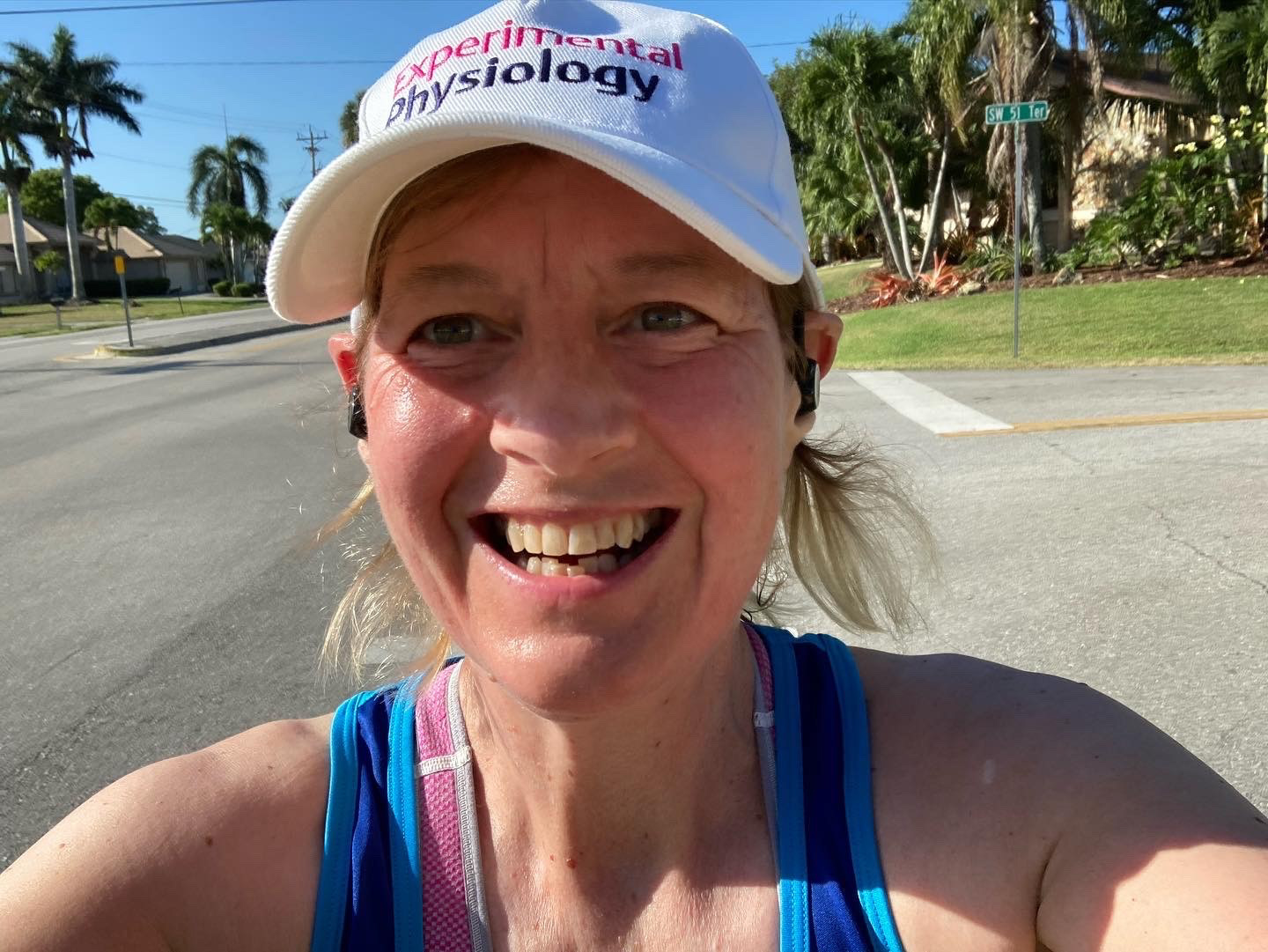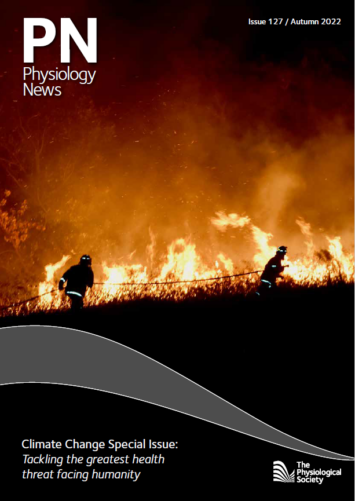
Physiology News Magazine
Chief Executive’s View
Climate change and how it has made me reflect on my running
News and Views
Chief Executive’s View
Climate change and how it has made me reflect on my running
News and Views

https://doi.org/10.36866/pn.127.7
Dariel Burdass
Chief Executive, The Physiological Society
As I write this, the UK is sweltering under its first ever red warning for heat and seeing temperature records smashed everywhere. In this heat we know that exercise including running should not be undertaken but I hadn’t considered the impact of air pollution, which is also affected by climate change.
I took up running when I hit 50 as I wanted a new and healthy challenge. I was fascinated with the simplicity, convenience, and freedom this form of exercise offered me, which I could also do outside. Having completed couch to 5 km (which I found an excellent way to get started), I signed up for a half marathon, purchased my first pair of running trainers and started to follow a training plan. What I love and continue to love about running is that it is the most basic human form of whole-body locomotive movement – you do not need fancy equipment, just your own body weight and two legs, to propel yourself forward. Also, it is never boring: you can run on your own or with friends, and every run is different as you can run on roads or trails, hills or flat, intervals or fartlek (a form of speed training). There is so much variety! And running, even leisure-time running, is associated with many reported health benefits; it promotes physical health by enhancing cardiovascular endurance, strengthening muscles, and building strong bones as a weight-bearing exercise. It also has an implication in lowering mental health burden (Garofolini and Taylor, 2019) (Jones and Carter, 2000) (Lee et al. 2017) (Markoti et al. 2020). What’s not to love?
To fit running around work I do most of it on the roads across London, from Paddington to our HQ at Farringdon. I have many different routes that range from 6 km through to 15 km and all on flat to rolling terrain. I am fascinated by the architecture and the interesting places I pass on my urban adventures, and this keeps me motivated whatever the weather. I have always seen the positives of running but working at a Society that has a focus on climate change I have become more interested in the negative impact that climate change may have on my running and ultimately my health. In particular, I would like to know how air quality may affect my well-being and what I can do to lessen the impact of air pollution as much as possible.
How climate change impacts the air we breathe: Air pollution and allergens
Background – here’s what I’ve learned:
Climate change poses many risks to human health and represents a massive threat to respiratory health (D’Amato et al., 2014) by:
- Directly promoting or aggravating respiratory diseases; or
- Increasing exposure to risk factors for respiratory diseases.
The main diseases of concern are asthma, rhinosinusitis, chronic obstructive pulmonary disease (COPD) and respiratory tract infections.
A staggering 91% of the world’s population lives in places where air quality exceeds World Health Organization’s (WHO) Air Quality Guidelines limits. With over 7 million premature deaths every year associated with exposure to air pollution, the WHO considers air pollution a major public health emergency (World Health Organization, 2022).
The annual economic burden of asthma and COPD on the NHS in the UK is estimated as £3 billion and £1.9 billion, respectively. In total, all lung conditions (including lung cancer) directly cost the NHS in the UK £11 billion annually (NHS England).
Air pollution
According to the National Climate Assessment, climate change will affect human health by increasing ground-level ozone and/or particulate matter air pollution in some locations (Centers for Disease Control and Prevention). When the temperatures are higher and there is more sunlight, the chemical reactions involving nitrogen oxides and volatile organic compounds speed up, creating more ground-level ozone. Breathing ozone irritates the lungs and the rest of the respiratory system, leading to shortness of breath. It can also cause inflammation and make the lungs more susceptible to other triggers of inflammation, such as pollen and mould spores, sometimes leading to infections. Rising temperatures intensify drought, causing dust and wildfires to fill the air with particle pollution at ground level. Air pollution also accelerates climate change.
Allergens
Climate changes affect allergenic plants and pollen distribution worldwide. These changes in temperatures cause an increase in the concentration of pollen in the air, the strength of airborne allergens and an increase in allergy symptoms (Asthma and Allergy Foundation of America). Climate change also causes some allergen producing plants to move into new areas, and winds can carry pollen and mould spores many miles to new geographical areas.
What this means for my running
Little seems to be known about the balance between the health benefits of physical activity weighed against the potential harmful effects of increased exposure to air pollution during outdoor physical activity. However, a recent article published in the European Heart Journal (Rae Kim et al., 2021) found there is a sliding scale when it comes to pollution, exercise, and risk of cardiovascular diseases (CVD). The researchers determined that individuals living in areas with low to moderate levels of air pollution who reduced their physical activity levels increased their risk for CVD. On the other hand, individuals living in areas with high levels of air pollution who increase their levels of physical activity may adversely affect their cardiovascular health.
Encouragingly, the British Heart Foundation12 reports that for most people, the benefits of being physically active outweigh the risks of breathing in polluted air. So, while I will check the air pollution level in the area I am running, I look forward to more research from our physiologists in this area and hope to see other physiologists on my runs across London For more information about the influence of air pollution on our health, read Dr Michael Koehle’s article in this issue of Physiology News.
PS: I am the one often wearing The Journal of Physiology or Experimental Physiology baseball cap.
If you are interested in respiratory physiology The Society in partnership with the British Pharmacological Society is running a Lung Summit on 21-22 November in London. Register now for “The Lung more than an organ of gas exchange”.
References
Asthma and Allergy Foundation of America. Climate and Health. Available online https://www.aafa.org/climateand-health/
British Heart Foundation. Is it safe to exercise outside in polluted air? Available online at https://www.bhf.org.uk/informationsupport/riskfactors/air-pollution#Heading7
Centers for Disease Control and Prevention. Climate change decreases the quality of the air we breathe. Available online at https://www.cdc.gov/climateandhealth/pubs/air-quality-final_508.pdf
D’Amato et al. (2014) Climate change and respiratory diseases. European Respiratory Review 23: 161-169; https://doi.org/10.1183/09059180.00001714
Garofolini A, Taylor S. (2019). The effect of running on foot muscles and bones: A systematic review. Human Movement Science. 64, 75–88. https://doi.org/10.1016/j.humov.2019.01.006
Jones AM, Carter H (2000). The effect of endurance training on parameters of aerobic fitness. Sport. Med. 29 (6):373-386. https://doi.org/10.2165/00007256-200029060-00001.
Lee DC et al. (2017). Running as a key lifestyle medicine for longevity. Progress in Cardiovascular Diseases. 60 (1):45-55. https://doi.org/10.1016/j.pcad.2017.03.005.
Markoti V et al. (2020). The positive effects of running on mental health. Psychiatria Danubina. 32, 233–235. PMID:32970641
NHS England. Respiratory disease. Available online at https://www.england.nhs.uk/ourwork/clinical-policy/respiratorydisease/
Rae Kim et al. (2021). Association of the combined effects of air pollution and changes in physical activity with cardiovascular disease in young adults. European Heart Journal 42 25,2487–2497. https://doi.org/10.1093/eurheartj/ehab139
World Health Organization (2022) Air pollution, a public health emergency. Available online at https://www.who.int/emergencies/diseases/novel-coronavirus-2019/mediaresources/science-in-5/episode-66—air-pollution-a-publichealth-emergency
